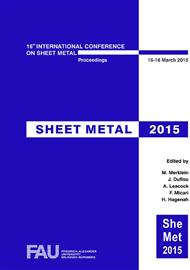p.325
p.333
p.339
p.347
p.353
p.361
p.369
p.377
p.385
Cold Formability of Automotive Sheet Metals: Anisotropy, Localization, Damage and Ductile Fracture
Abstract:
Experimental and numerical investigations on the characterization and prediction of cold formability of two different types of automotive steel sheets, a ferritic stainless steel sheet (AISI 439) and a dual-phase steel sheet (DP600) are performed in this study. Due to the different microstructure configurations, these two steels show significant differences in plasticity behavior as well as failure mechanisms. The ferritic stainless steel shows strong anisotropic plastic deformation in terms of both yielding and hardening, whereas the dual-phase steel behaves quite isotropic resulting from the mixture of two phases. However, unlike the localization dominant failure mechanism of the ferritic stainless steel, the incompatible deformation due to the distinctions of the mechanical properties of two phases naturally results in early damage and extensive damage development prior to localization, or ductile fracture without localization. In this study, all these features are taken into account for an accurate prediction of formability. A general modelling framework with specifications for these separate features is formulated and applied to the two steels.
Info:
Periodical:
Pages:
353-360
Citation:
Online since:
March 2015
Keywords:
Price:
Сopyright:
© 2015 Trans Tech Publications Ltd. All Rights Reserved
Share:
Citation:


